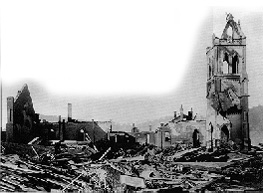|
U. S. Timeline
|
| Chicago Fire, 1871 |
| Peshtigo Fire, 1871 |
| New York Blizzard, 1888 |
| Johnstown Flood, 1889 |
| Galveston Hurricane, 1900 |
| San Francisco Earthquake, 1906 |
| Titanic, 1912 |
| 1918 Flu Epidemic |
| Mississippi River Flood, 1927 |
| Dust Bowl, 1930s |
| Hilo Tsunami, 1960 |
| Mt. St. Helen Volcano, 1980 |
| Grand Island Tornado, 1980 |
| San Francisco Earthquake, 1989 |
| Kilahuea Volcano, 1983-present |
| Hurricane Iniki, 1994 |
| |
|
World
|
| New Zealand Volcano, 1996 |
|
|
|
|
|
|

Photo: Library of Congress Print and Photograph Collection. |
| Natural disasters have played
an important role throughout human history. In early times, people created
myths to describe their experiences with fire, flood and other violent
forces. Over the centuries, new scientific discoveries added to their knowledge.
Yet even today such events affect the lives of millions of Americans
and people still seek ways to reflect on their encounters with Nature's
Fury.
Use the timeline at left
to examine historic American experiences with Nature. As you explore
an event, keep in mind these key questions:
-
What assets can people and communities
develop to respond to such events?
-
How do photographs, personal narratives,
and poetry in the form of lyrics, help us to understand human experiences?
-
Is nature an enemy to be conquered
or a force with which humans must cooperate?
|
|
|